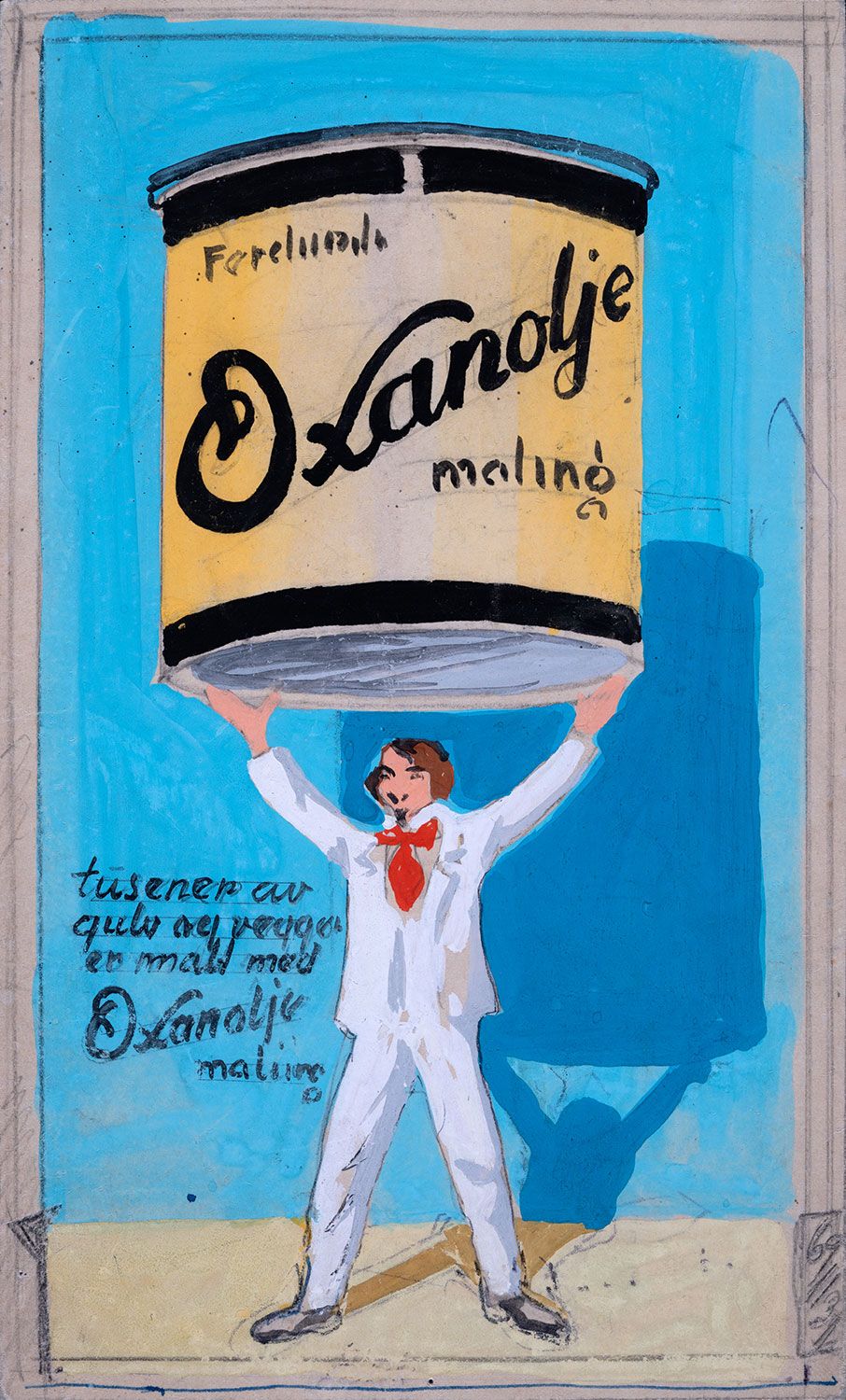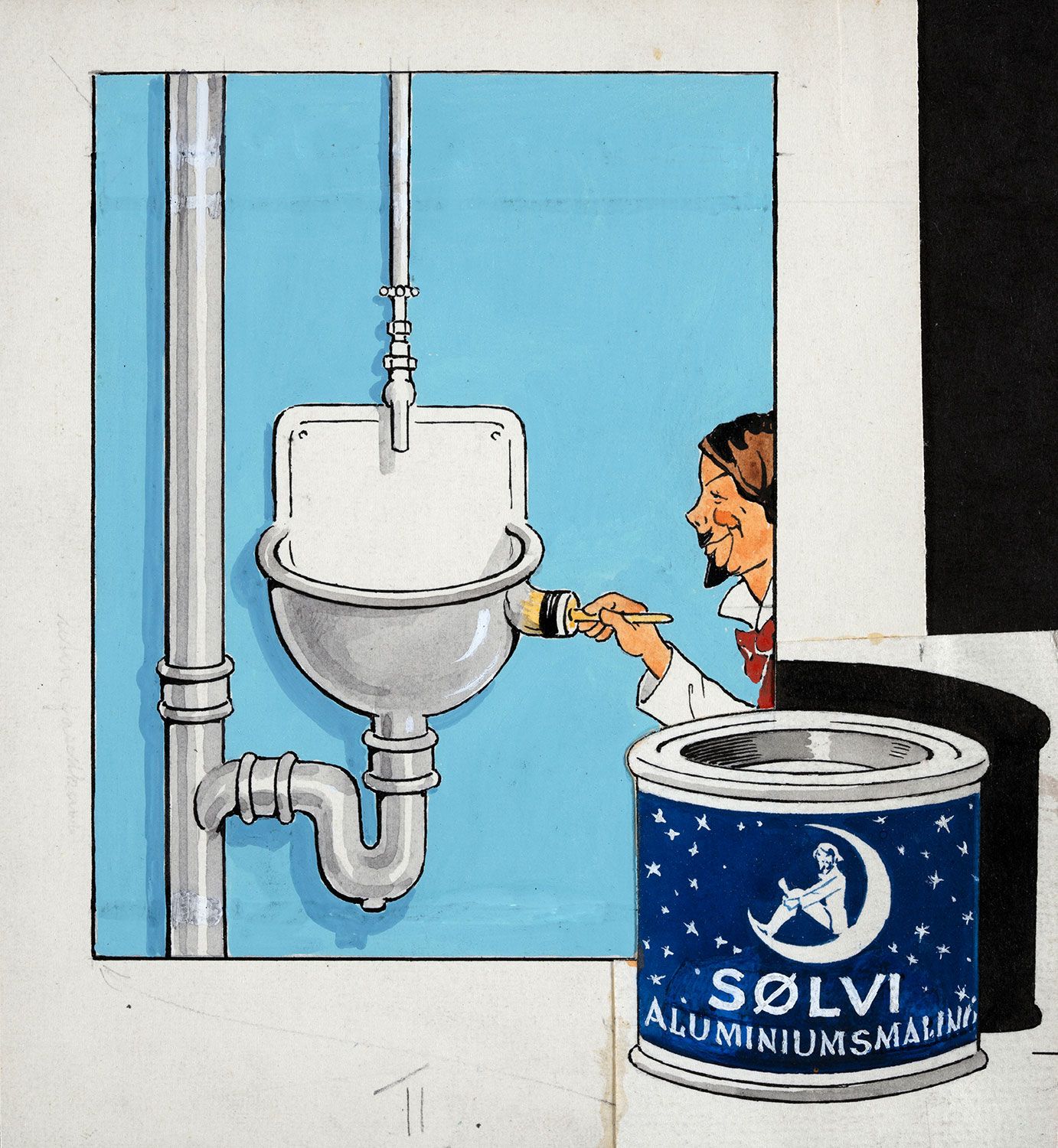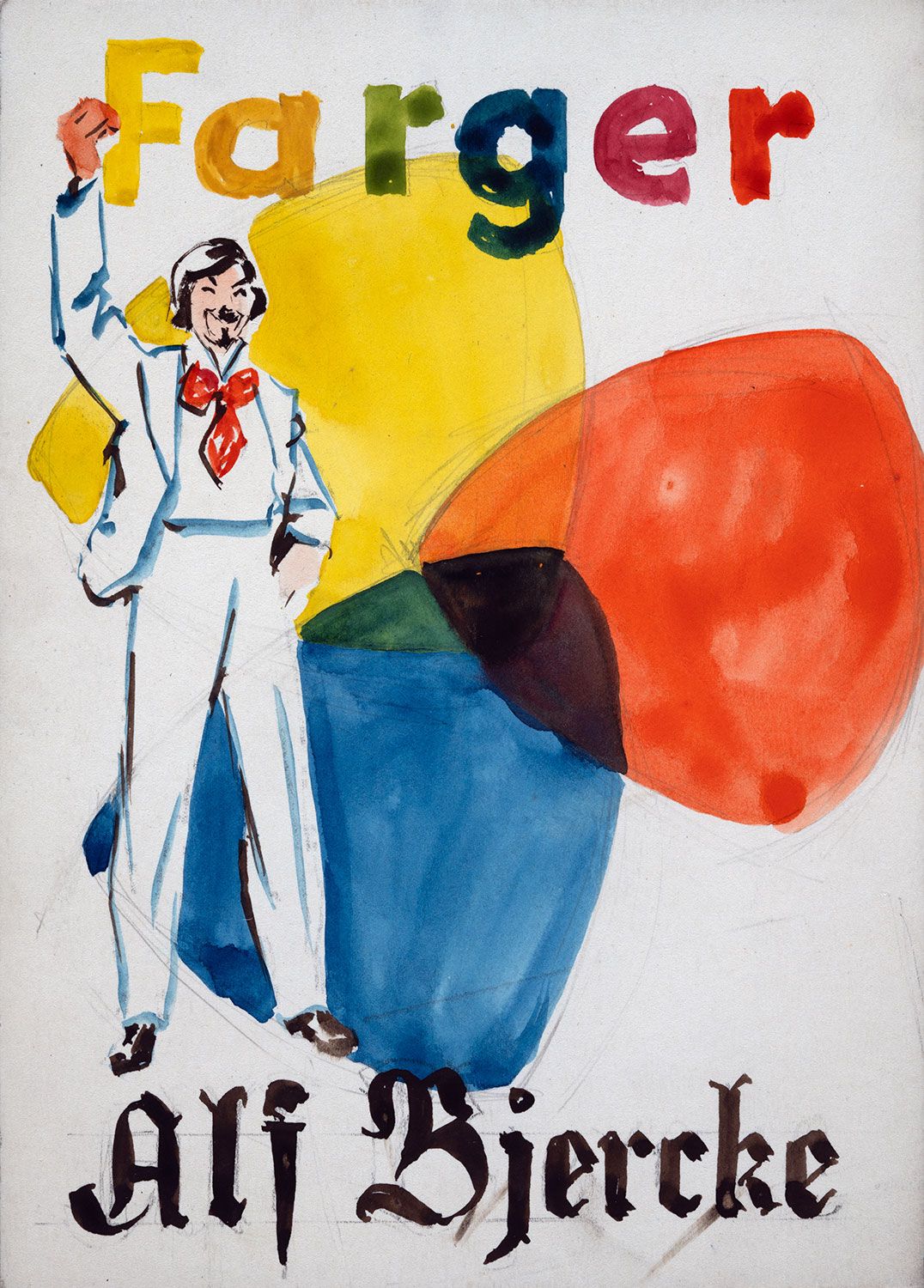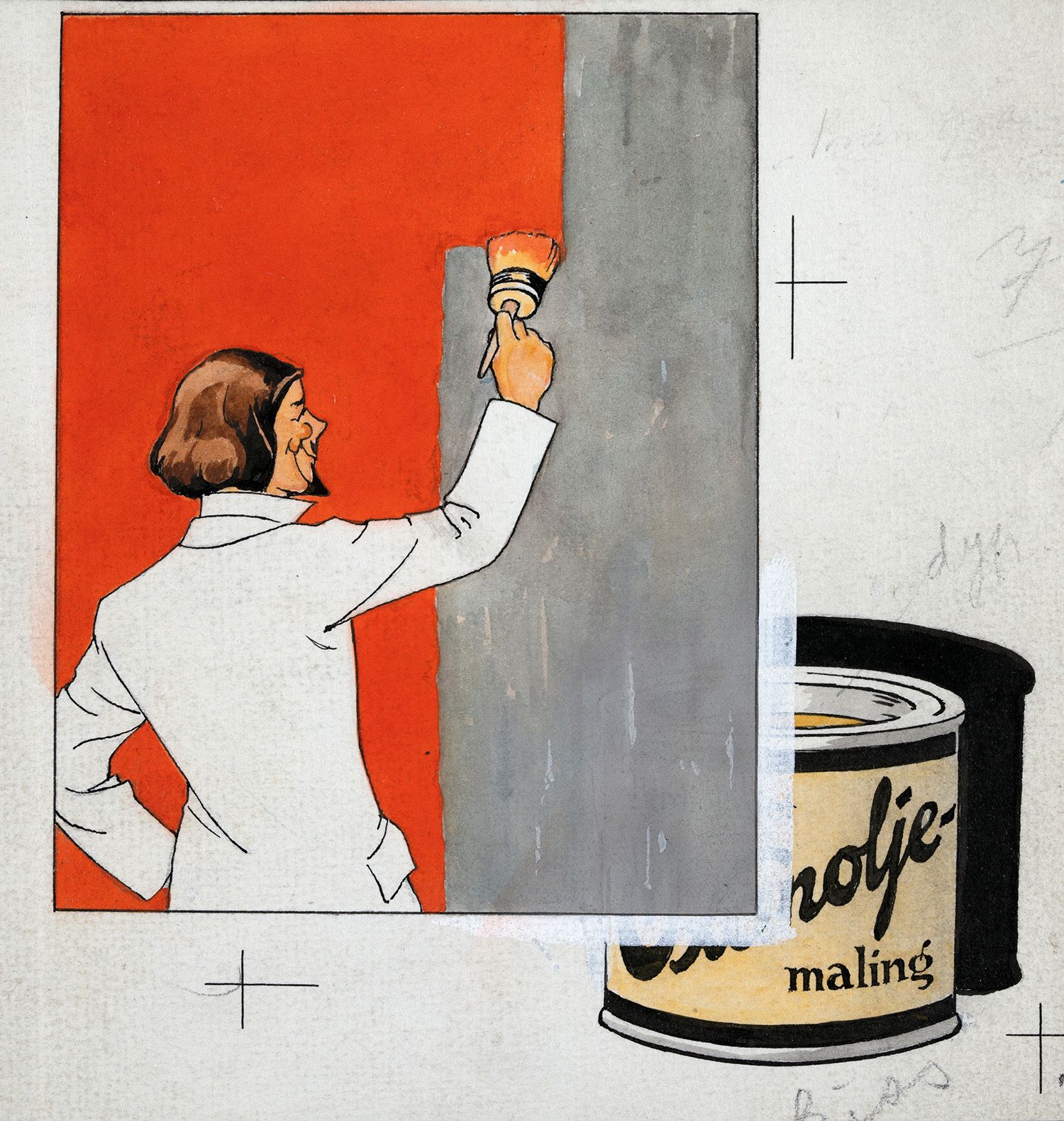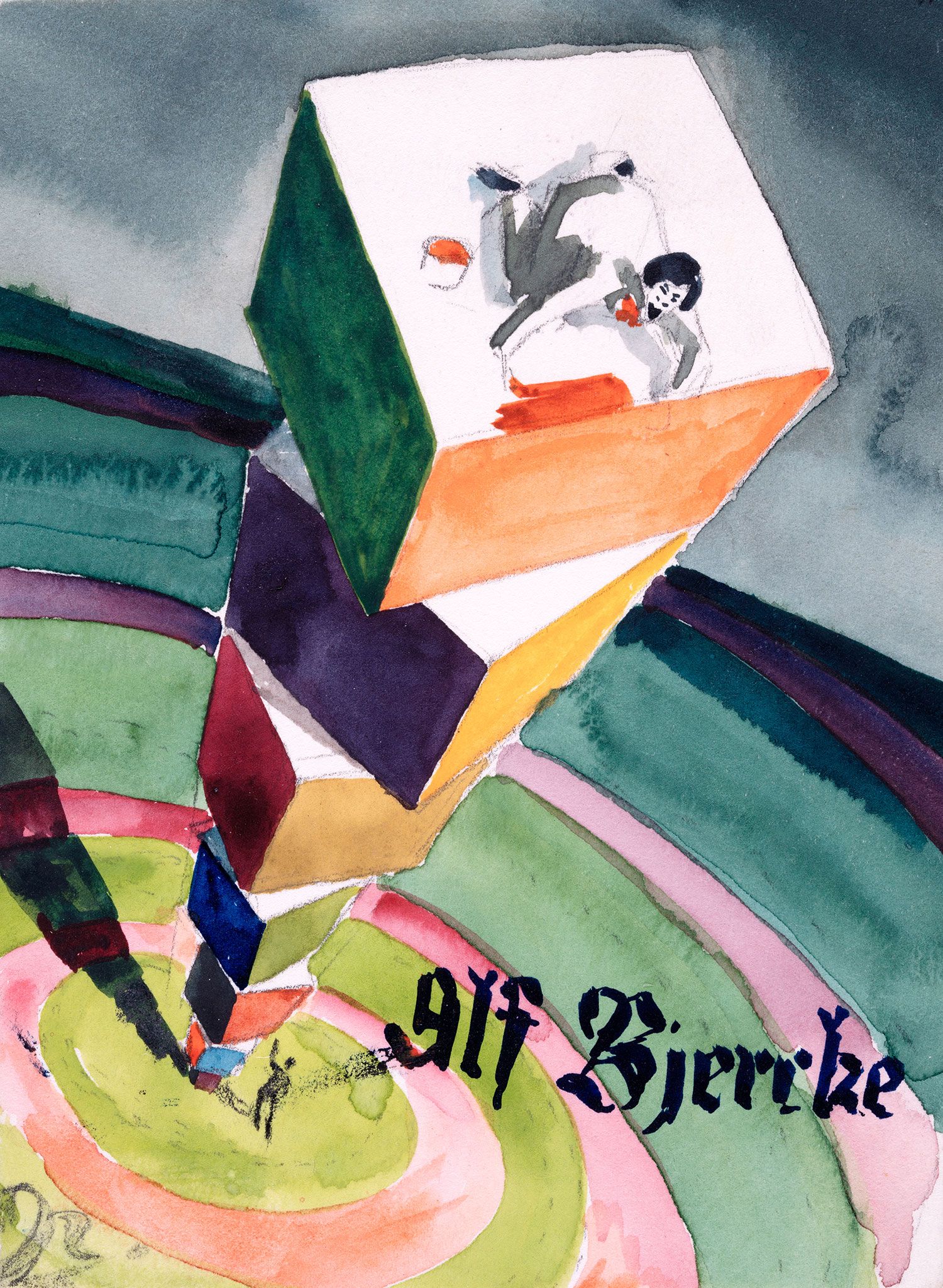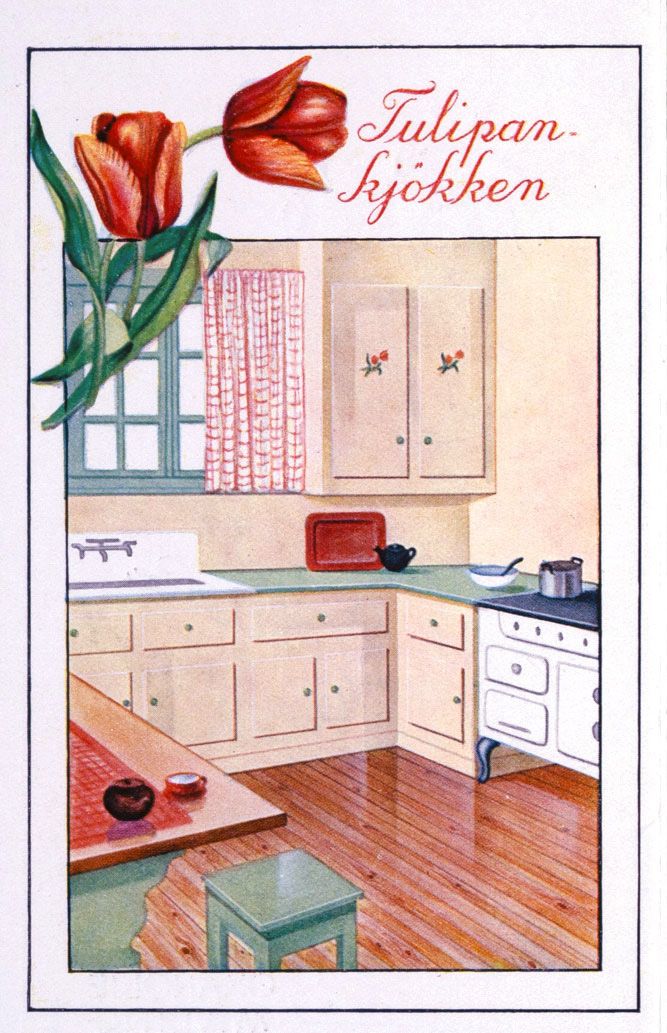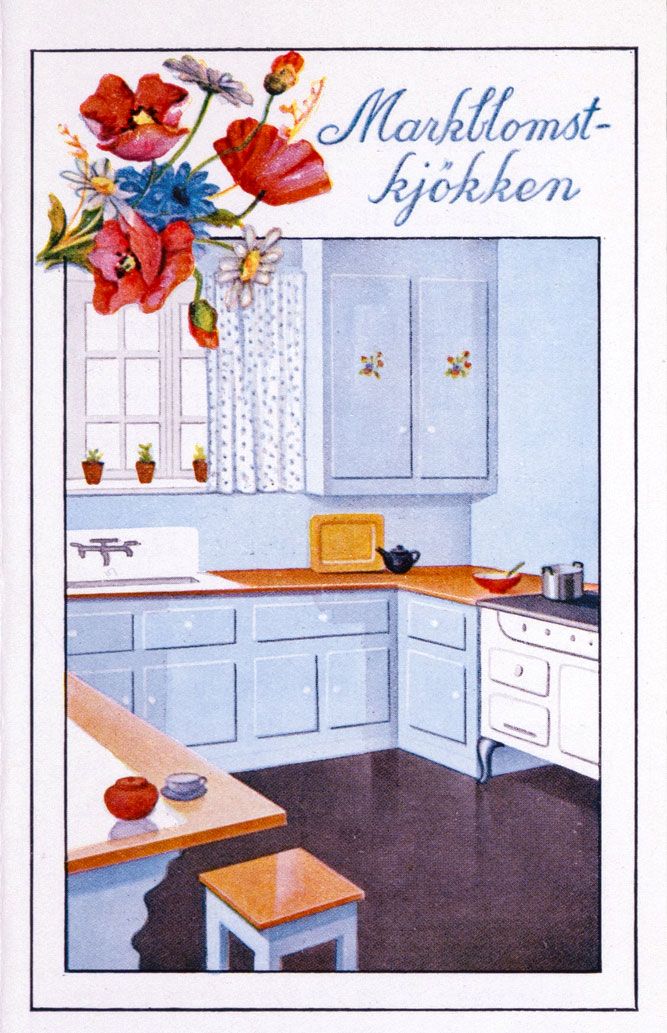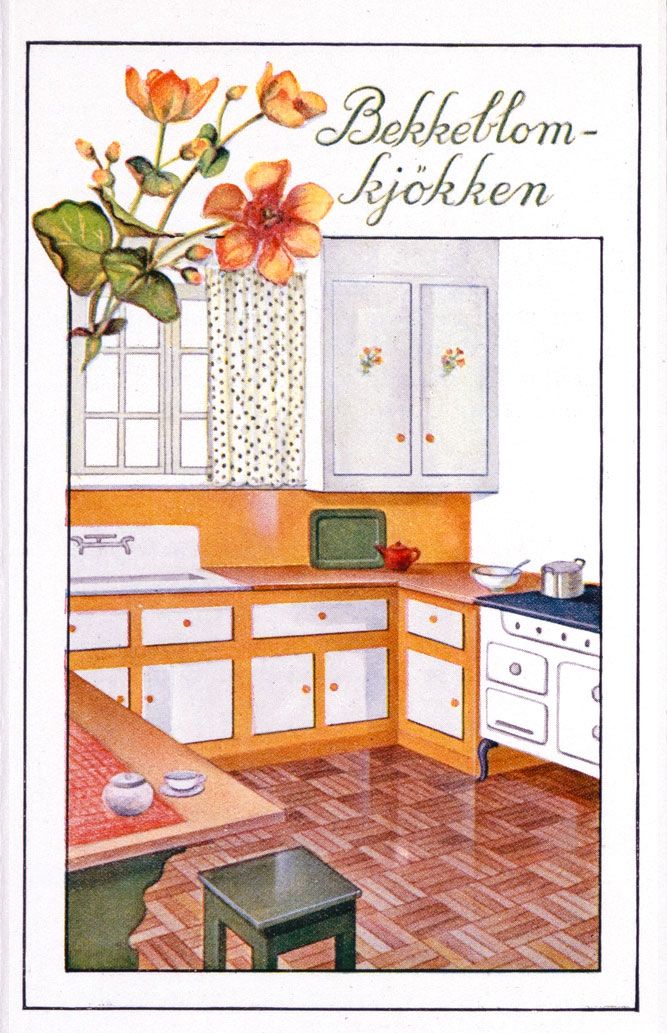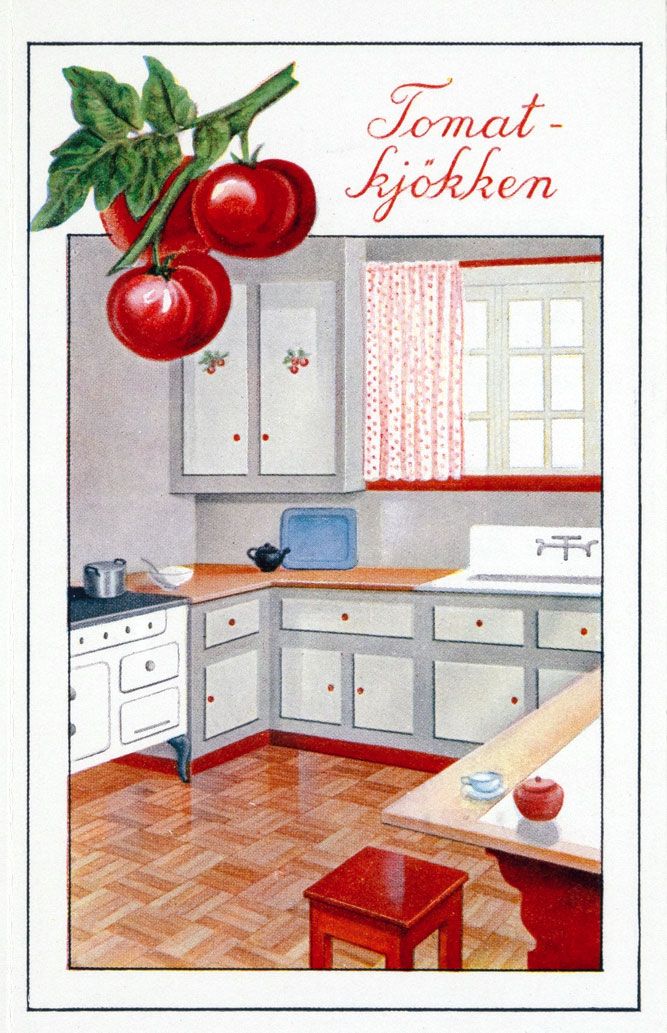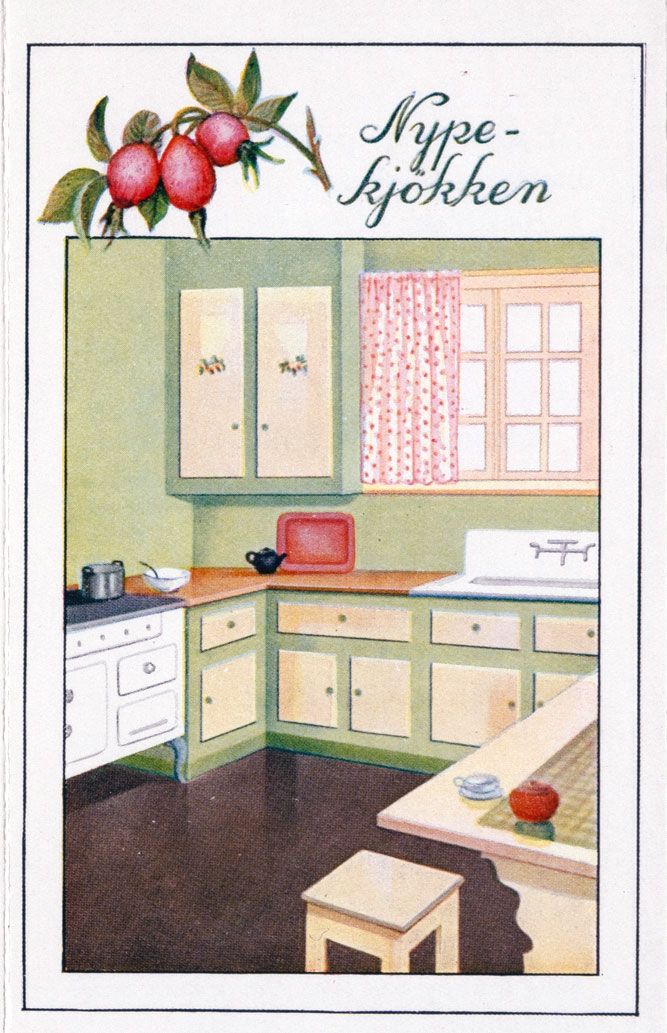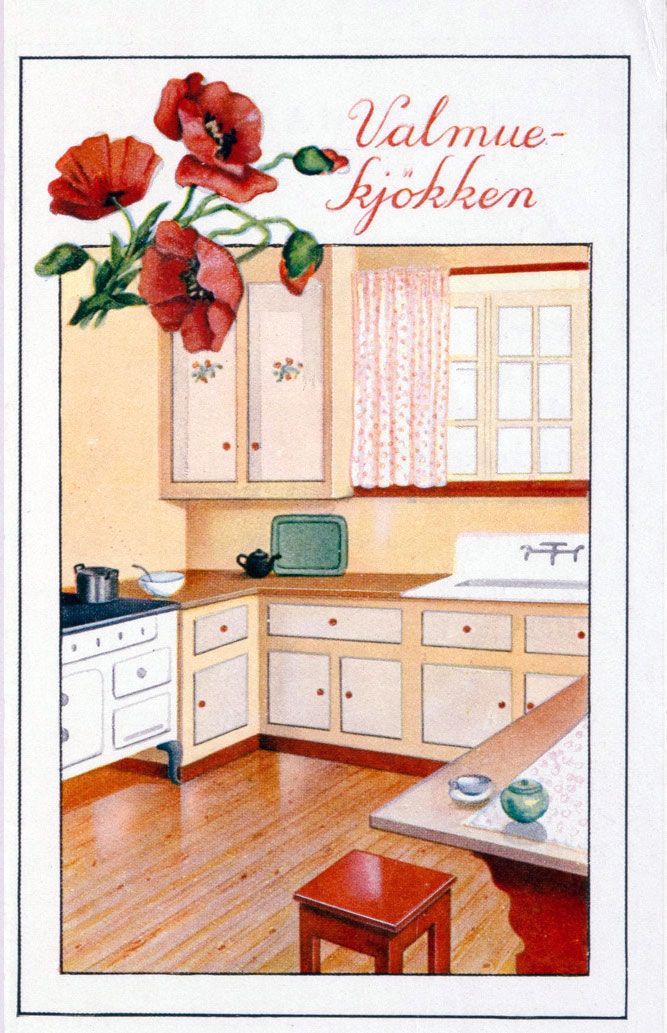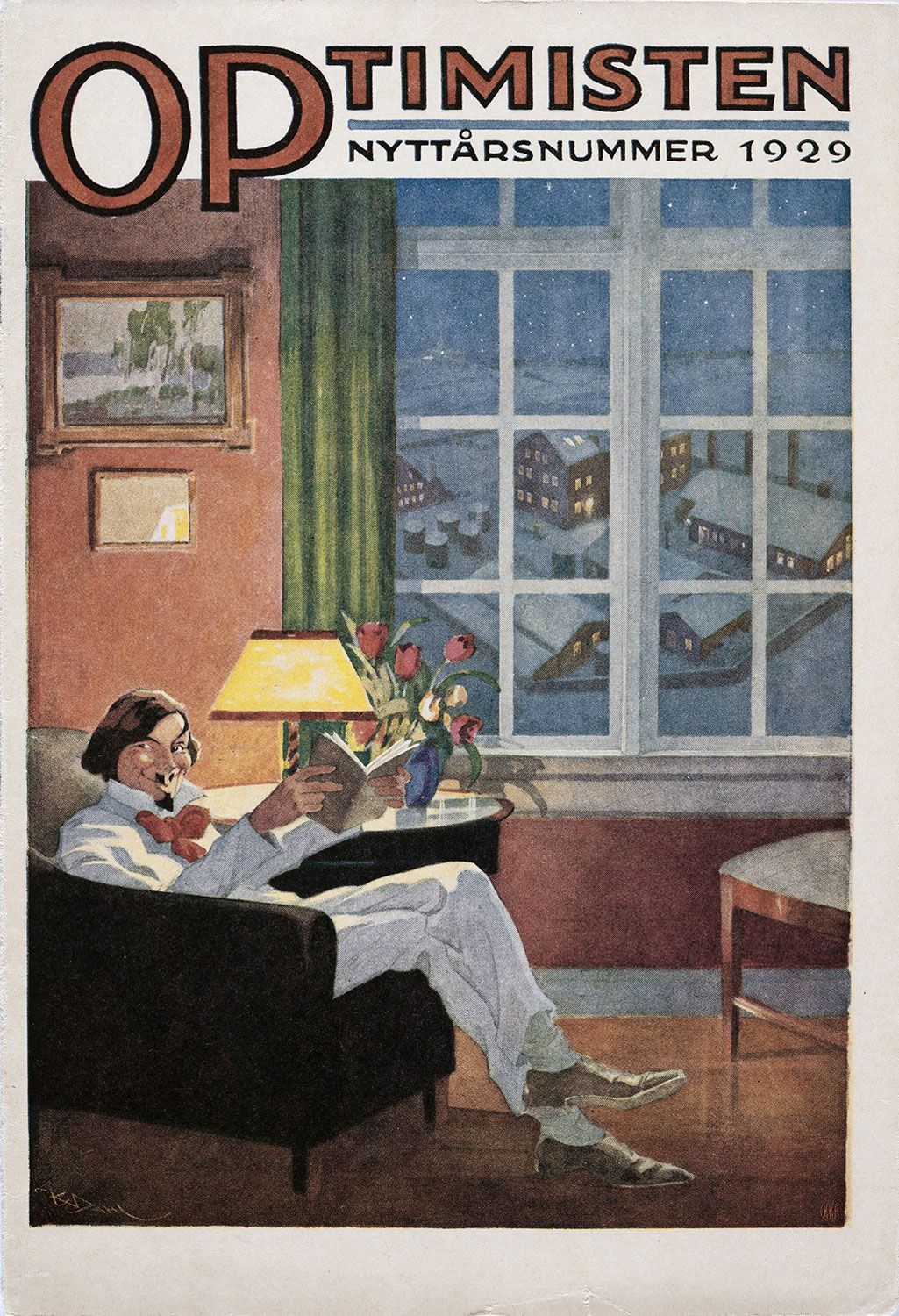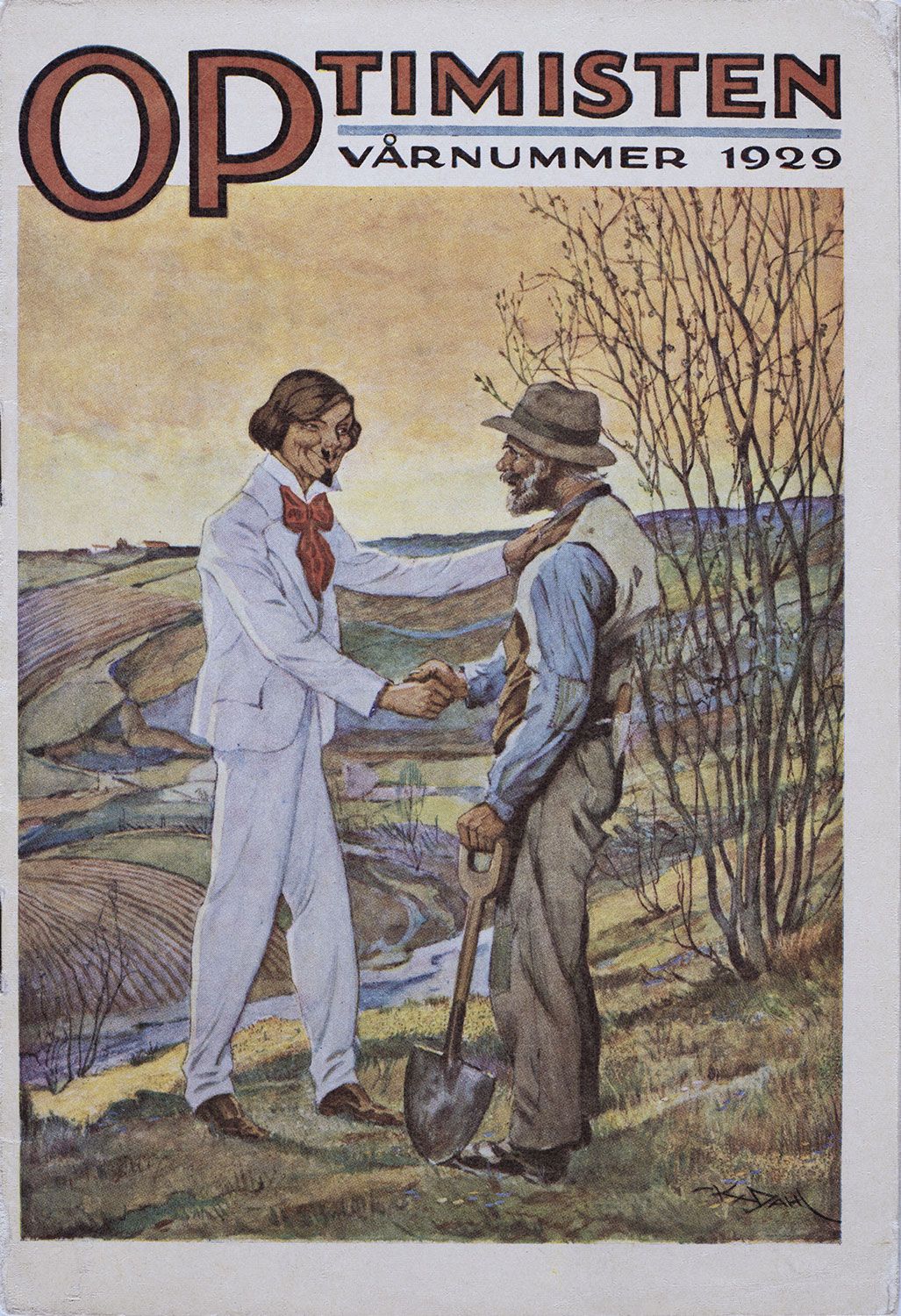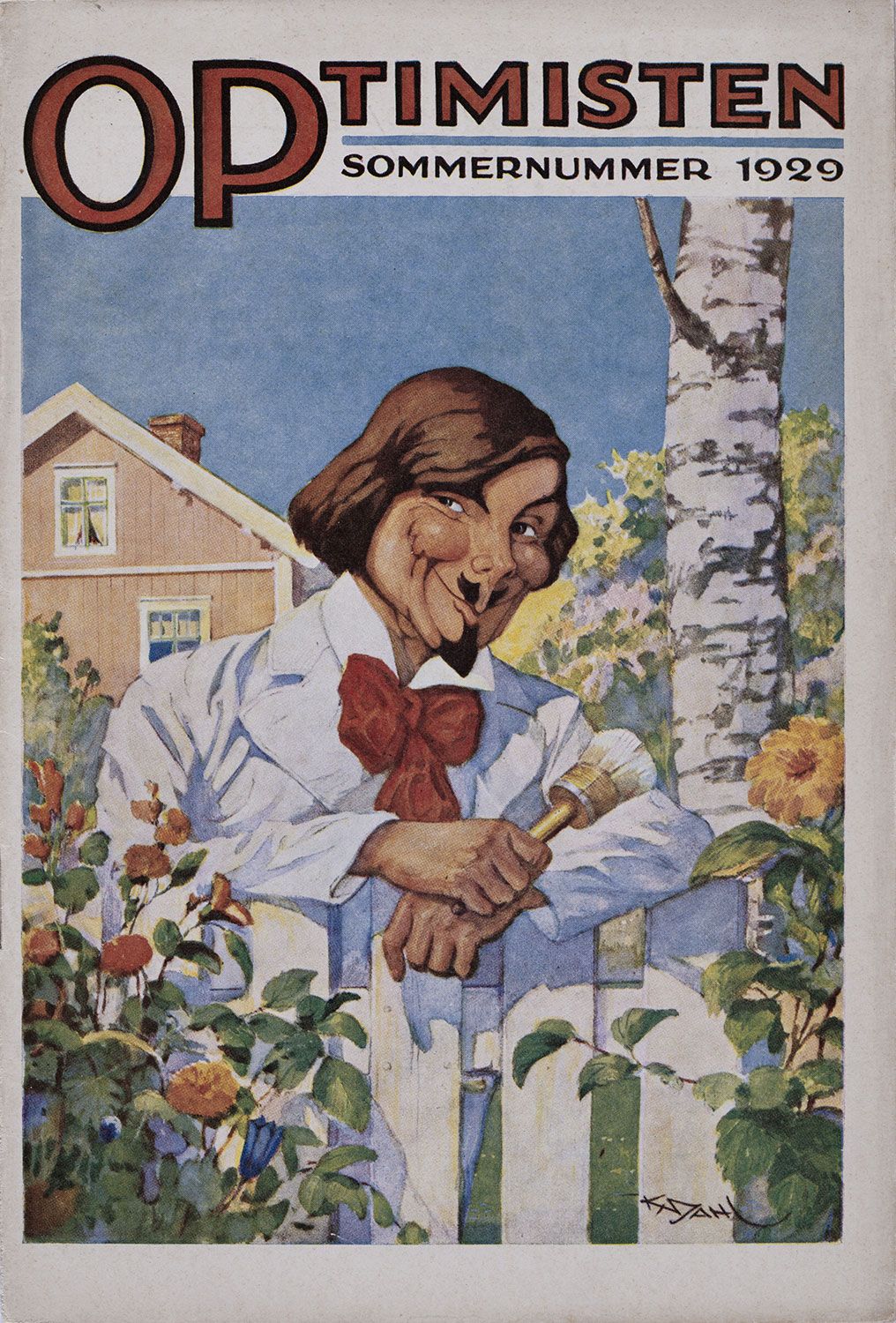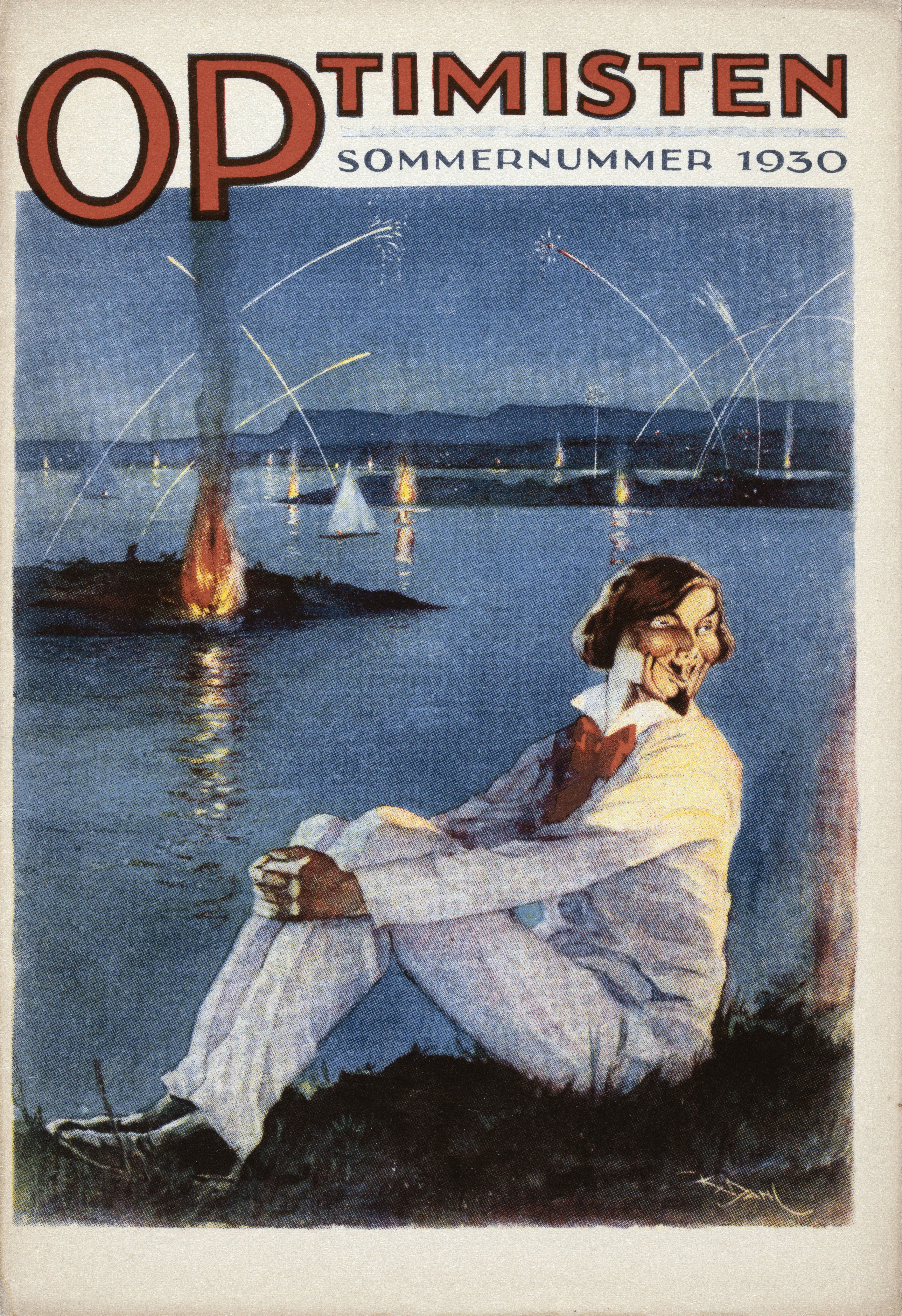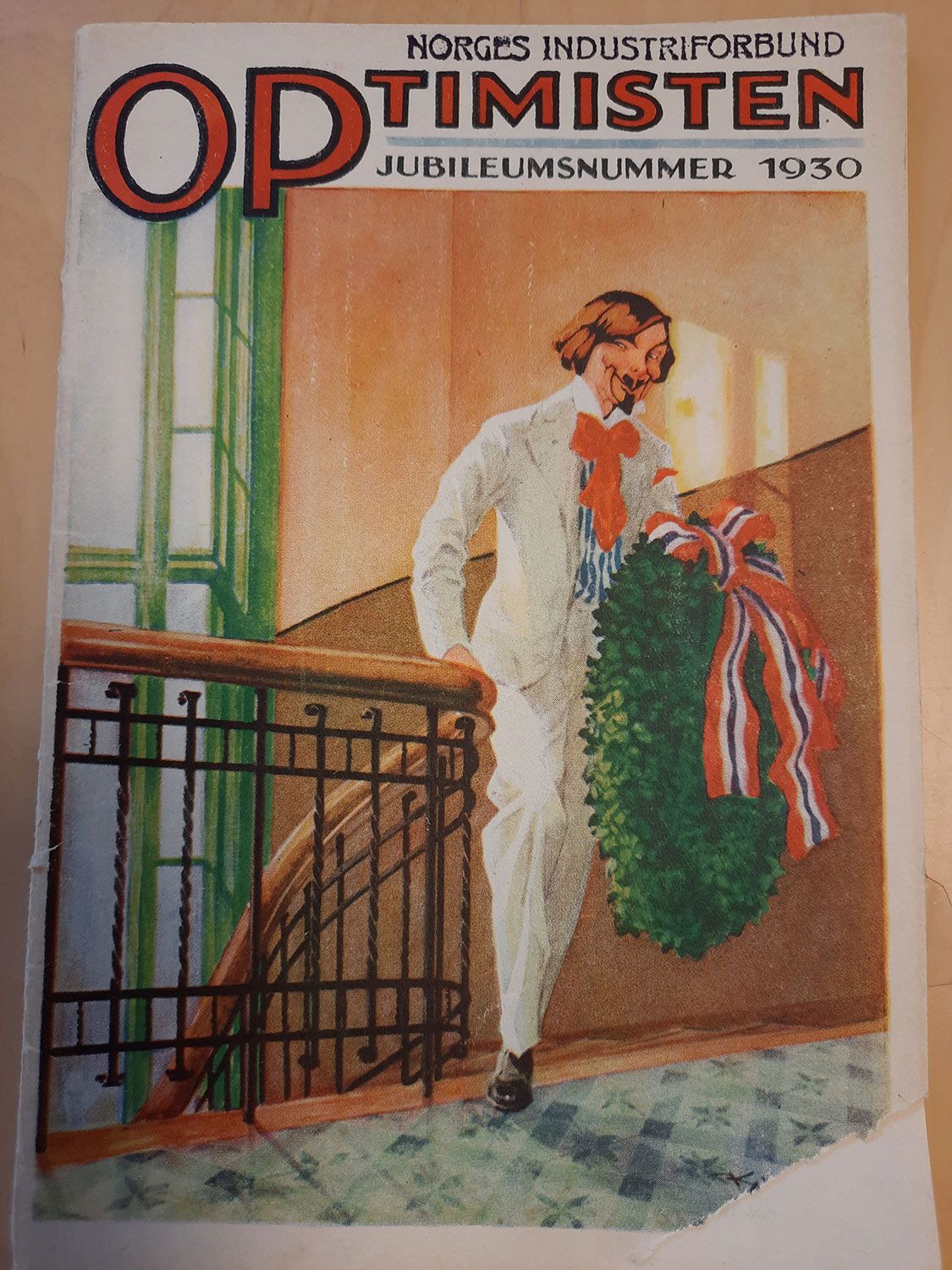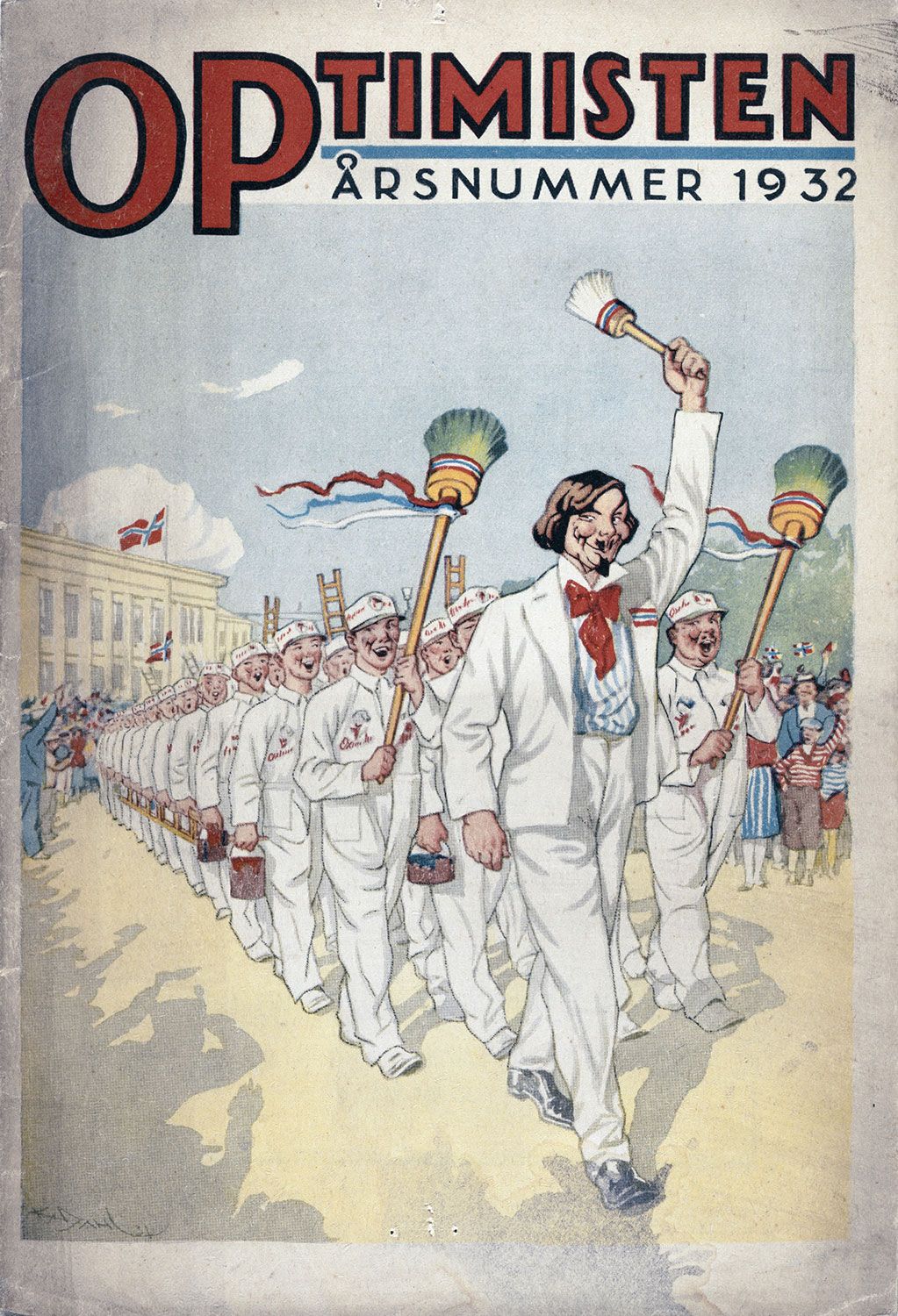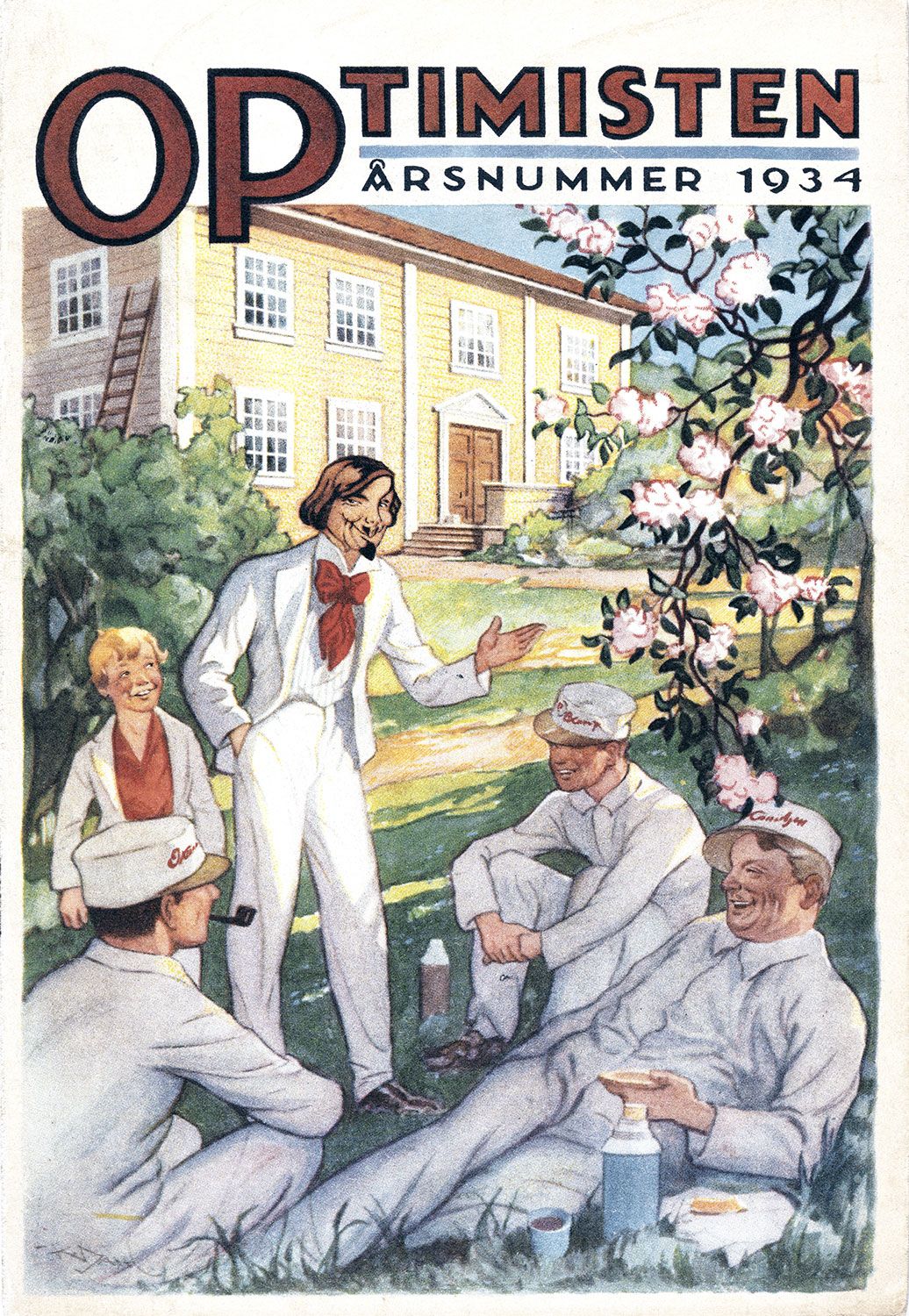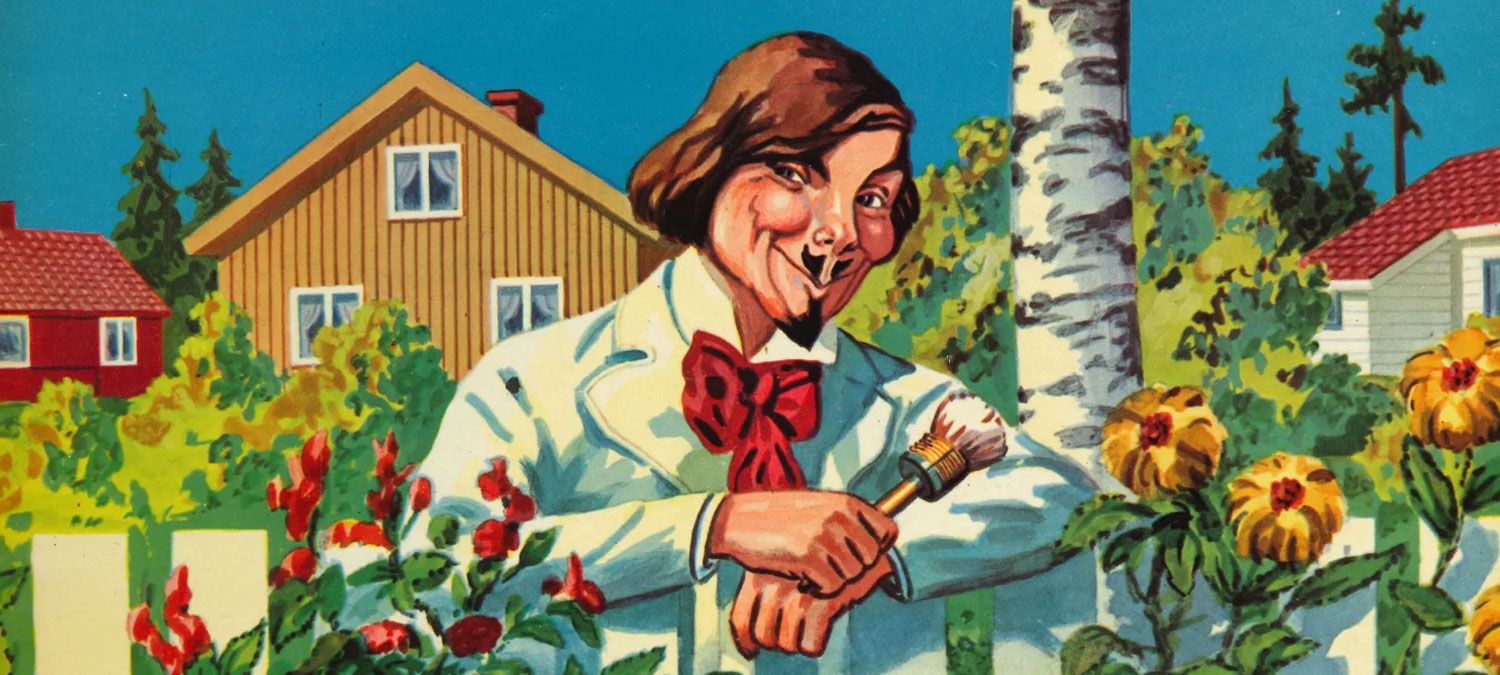
Alf Bjercke
Funkis colors and lacquer factory
The Oslo company Alf Bjerke was in the middle of the 20th century the country's largest producer of paint and varnish for houses and interiors. After the merger with Jotun in 1972, the rich archive, which among other things contains color maps, photos and advertising material, was given to The Norwegian Museum of Science and Technology .
History
Alf Bjercke paint factory
Alf Bjercke fargehandel was founded in Oslo in 1880. In the beginning, the company sold apothecaries, dyes and a number of other chemicals. Ten years later, a separate factory was built to produce lacquer and varnish for the protection of painted surfaces, especially wood. The company had a factory at Alnabru and a business and head office at Skippergata 29. The shop had several departments, including a large art department. However, it was within interior paint and varnish that Alf Bjercke was best known.
When Alf Bjercke started the business, painting was exclusively a vocational subject. Lacquer and paint were fresh products and had to be mixed on site. Eventually, ready-mixed products became common. Alf Bjercke was a pioneer in preparing color charts for the various types of paint and varnish. The factory mainly worked with colors for floors, walls, ceilings and mouldings, but also had products for outdoor painting, such as stains and cover paint for villas and bungalows with wooden panels, metal paint and various types of colors and impregnation agents for textiles and leather goods. After the Second World War, there were new products such as car paint and an increasing focus on exterior paint.
Alf Bjercke worked closely with Swedish paint factories and started a factory in Ethiopia in 1966, closed in 1975 in connection with the deposition of the Western-oriented emperor Haile Selassie. In 1972, the factory was bought by Jotun in Sandefjord and the production in Oslo closed down.
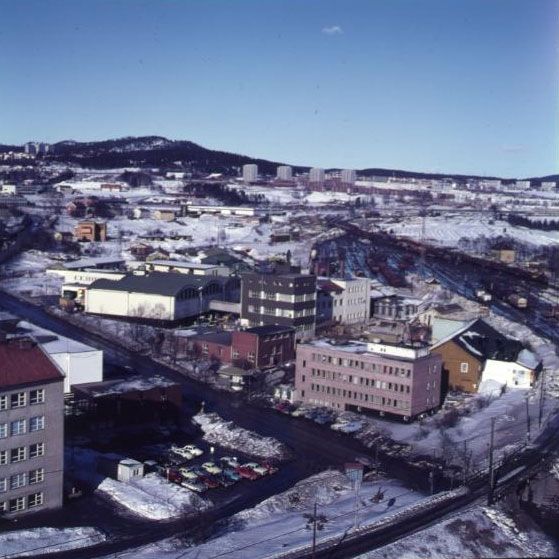
The paint factory at Alnabru
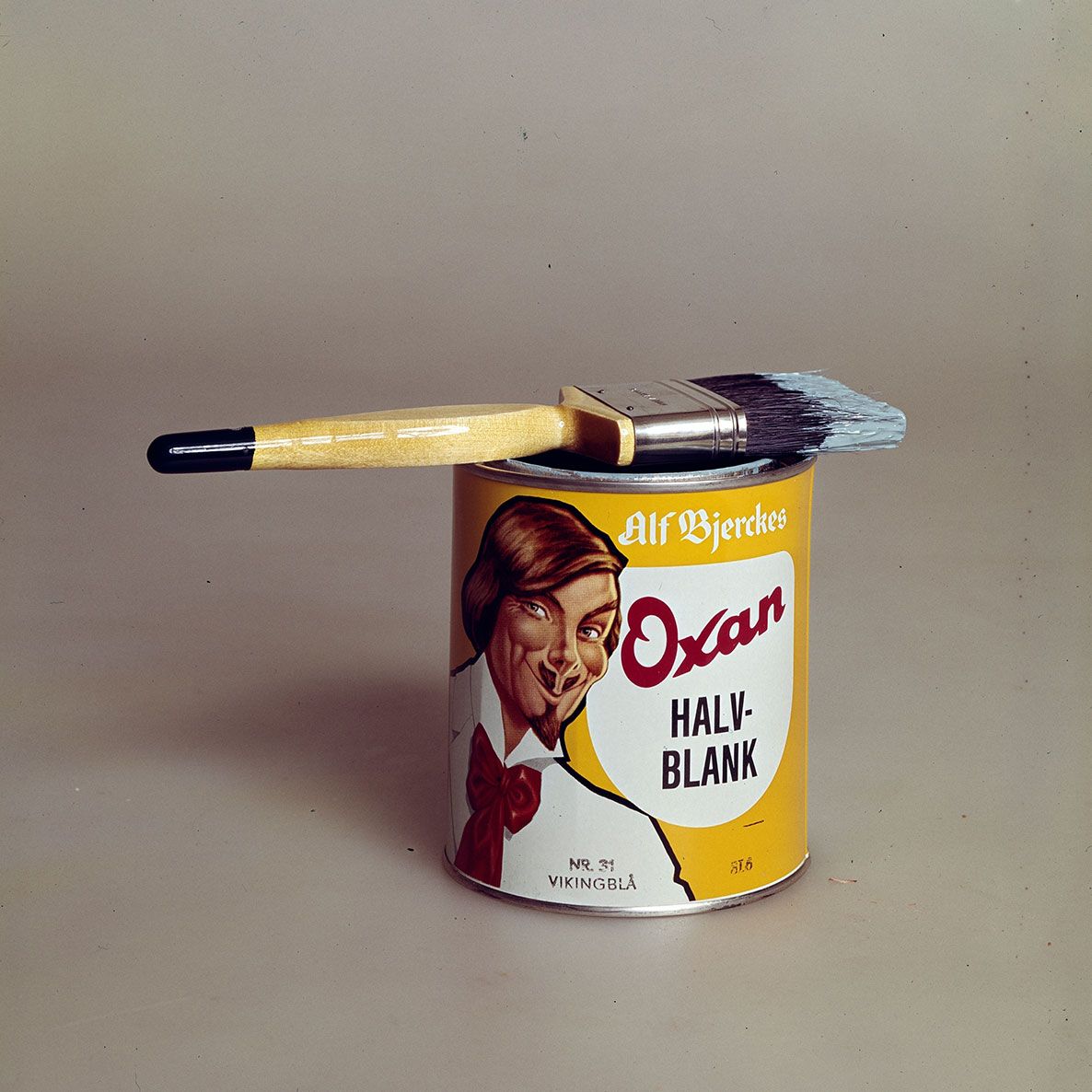
Alf Bjercke's Oxan semi-gloss. Photo: Sohlberg Foto (approx. 1958–1979)
The founder
Alf Bjercke was the founder of the business and company of the same name. As a young man, he worked with chemicals and paints while learning languages and business.
At the age of 29 in 1880, he founded his own company, initially dealing in chemicals. After learning, among other things, varnish cooking abroad, he started his own production of oil and varnish.
Alf Bjercke was active in the Norwegian Chamber of Commerce, sat on several company boards and in the city council for the Conservative Party. He died in 1933. By then, two of the sons, Richard and Alf, had long since taken over the business and the company was entering the modern era where advertising meant just as much as the product. But no one in the Bjercke family was a model for the advertising character Maler'n, which was to become one of the country's best-known brands.
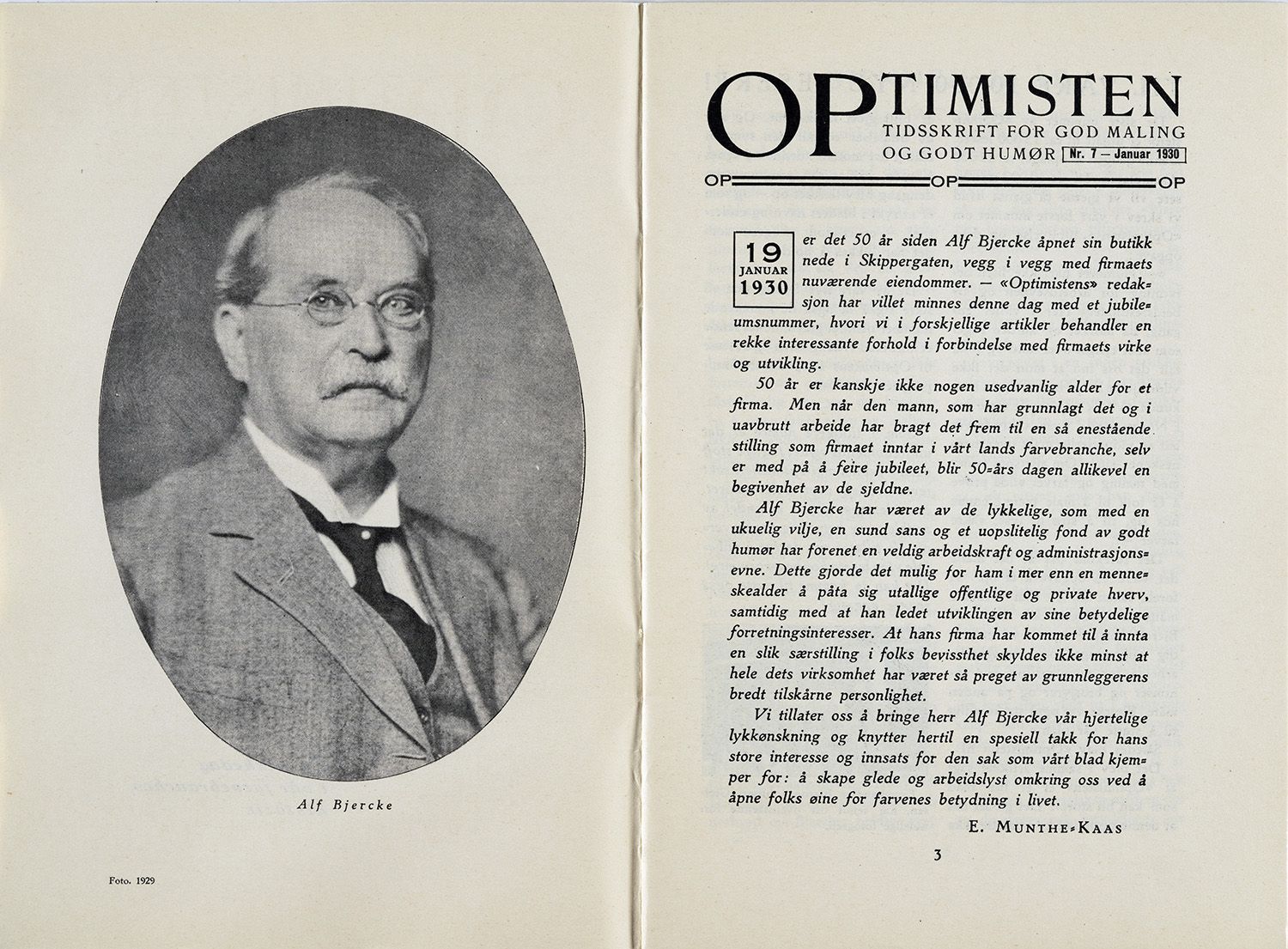
Maler'n til Bjercke – Norway's most famous advertising figure?
In the middle of the 1920s, Alf Bjercke developed the advertising figure Painter'n. He was to front paint products for decades to come and soon became part of the cityscape across the country. He was not a real person, but an easily recognizable fantasy figure with a goatee, long bangs, a white painter's coat and a red bow around his neck who was displayed in the shop windows of paint dealers, painted on firewalls and attached to Oslo's trams.
The company's mission was a "humourous 'painter's fellow' who would lean against one of Bjercke's lacquer jugs and reflect the joy of using Alf Bjercke's paint and lacquer", as described in the company's anniversary book in 1955. The first edition, a three-dimensional figure , was created by sculptor Andreas Enderlé in 1915.
The figure was further developed into one with a "twinkle in the eye" by Karl Dahl. He was a renowned advertising designer and children's book illustrator and taught the subject at the Statens Håndverks og Kunstindustriskole (SHKS). He is also known for having designed the insurance company Gjensidige's scales, which are still in use.
In the coming years, Maler'n spread as a trademark on all packaging from the company, in magazines and newspapers and in the cityscape. When a Nordic advertising meeting was held in Oslo in 1933, Richard Bjercke was asked to give a lecture about Maler'n as a representative of Norwegian advertising and the figure's countless versions and placements. Its popularity remained until the 1970s as long as the Bjercke paint was on sale.
Color trends
The color chart
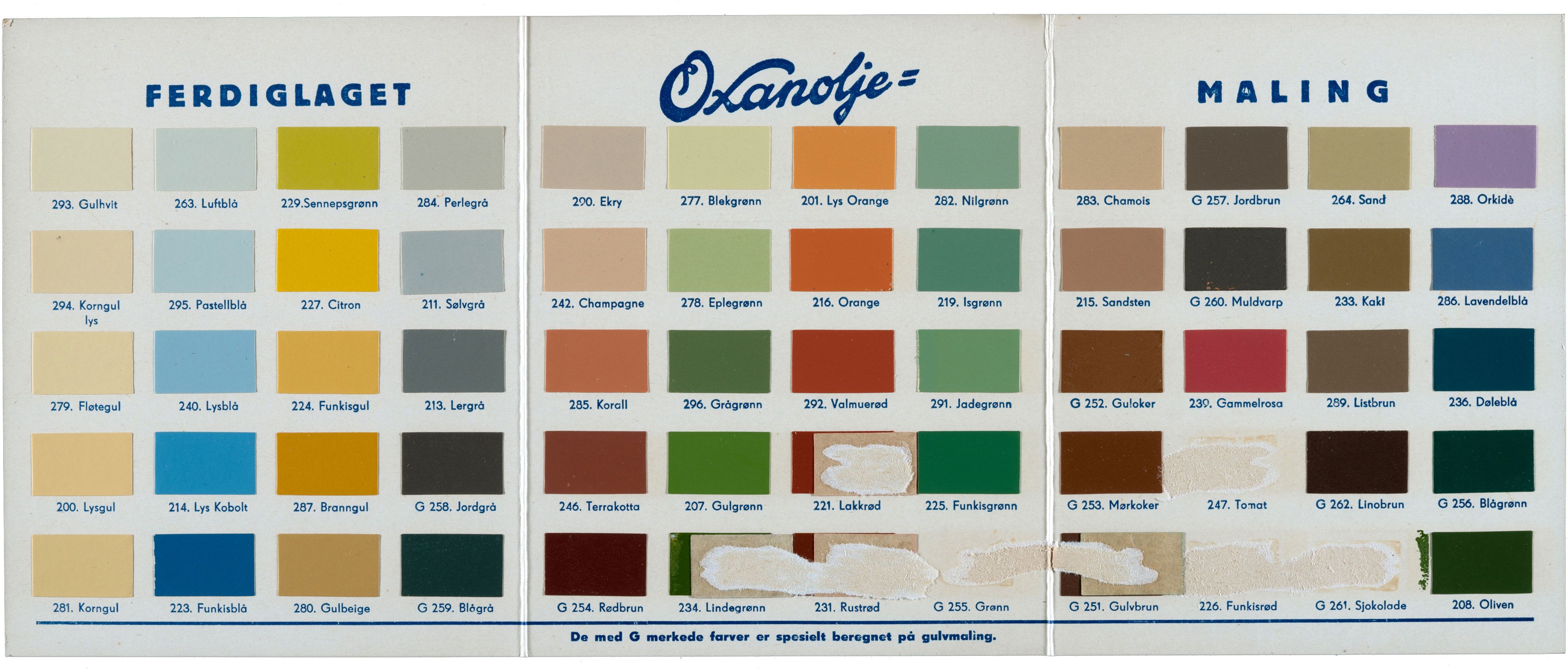
Own color charts made it easier to choose paint
Alf Bjercke's main product in interior paint from around 1920 was Oxan. It was new that a white base for the paint was ready-made and then colors were added according to our own coded color systems. This is still done today through, for example, the NCS color system and Pantone.
Alf Bjercke made a separate color chart for 60 colors in the color chart "Oxanfarger - ready-made paint". All colors had numbers and numbers, and the colors that existed in floor paint quality were marked with a G. The customers, whether they were professional painters or private individuals doing renovations, could choose colors from predefined palettes of trendy colors. Painting should be easy for everyone, and the do-it-yourself ideology grew.
Caption for color palettes - library
The color picker

Alf Bjercke invented the "Color Picker" - a tool to see how colors worked together in practice.
It was still difficult to choose the right colors. How did the composition of colors work in practice? Alf Bjercke launched Farvevelgeren in 1928. It was a box with cut-out parts of a room: ceiling, walls, floor and door on the background wall, set up in perspective. Different parts of the room in different colors could be put together in countless combinations.
The invention was Alf Bjercke's own, and the factory patented it in Norway and Germany. The colors and the proposed compositions, with different proposals for the different rooms of the house, were prepared by decorative painter Theodor Wilberg. He had learned interior decoration in New York in the 1890s and was head teacher of the decoration line at SHKS from 1912-1928.
The color selector guided the consumer, and much of the industry's advertising in the future was about this. In 1930, the box was sold out from the publisher, according to information in the women's magazine Urd. The color charts were probably easier to both create and explain to the customer.
Interior trends from the USA

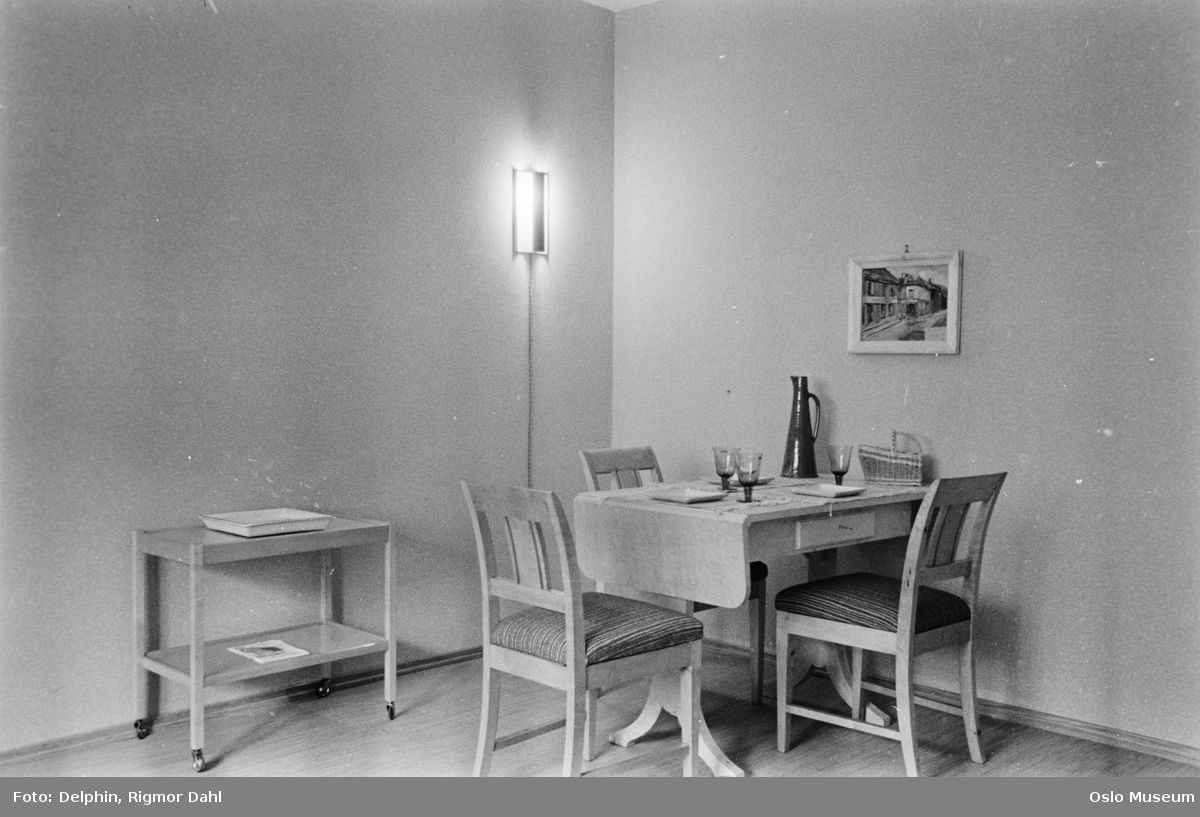
Kikka Frii's model apartments at Tøyen (1939). Photo: Delphin, Rigmor Dahl
Interwar homes were supposed to be delicate in light or fresh colors. Clean painted surfaces in light colors were easy to keep clean and helped make the rooms bright. Both architects, social reformers and industry were concerned with beautiful everyday goods as formulated by the Swedish architect Gregor Poulsson. It was about people's homes, and the housewife was largely the target of the propaganda.
In 1935, Alf Bjercke employed the consultant Kikka Friis. She had studied home decoration in the US and guided customers in choosing paint and color combinations. The factory also had its own viewing apartment at Tøyen. Together with interior design experts from leading furniture stores, in an article in the weekly magazine Vi selv og våre hjem in 1935, she recommended colors and interior products for the decoration of three different rooms in which Alf Bjercke's colors were included.
Flower kitchens
Alf Bjercke launched a series of Flower Kitchens in 1937. Friis was the designer. Each kitchen was named after its own plant, such as tulip, field flower, watercress, tomato, rose hip and poppy.
Tulip kitchen
Cream
Jade green + 4 parts white
Ceiling, walls, door and cupboard: Cream Oxan oil paint no. 304
Window, worktop and furniture: Jade green Oxan oil paint no. 291 mixed with 4 parts white Oxan oil paint
Tabletop: Lacquered with Ultra Light Parquet Lacquer. Pine floor: Oil with Oxan oil
Wildflower kitchen
Air blue
White
Earth grey
Walls, cupboards and furniture: Air blue Oxan oil paint no. 263
Roof, window and door: White Oxan oil paint
Table, worktop and stool top: Lacquered with Ultra Light Parquet Lacquer
Floor: Earth gray Oxan oil paint no. 258
Bekkeblom kitchen
White
Funky yellow
Grey-green
Ceiling, walls, windows and cupboards: White Oxan oil paint
Kitchen bench: Funky yellow Oxan oil paint no. 224 with white doors
Furniture: Grey-green Oxan oil paint no. 296
Floor, table and worktop: Lacquered with Ultra Light Parquet Lacquer
The flower kitchen's brochures were based on the same template: a kitchen with kitchen bench and upper cupboard, electric cooker, sink with running water, window and kitchen table with stool; everything adapted to modern family life with technical aids and bright washable surfaces. Kitchen fittings, furniture and walls harmonized with the painted small bouquets on the brochure, which had been transferred to the cabinet doors using stencils. Kikka Friis had gotten the idea for these in the USA through the company Nu-Enamel's flower kitchens, which were based on the same principles.
The issue of plagiarism came up in 1936, since the American kitchen was patented. Nevertheless, it does not seem to have had any significance for the launch of Alf Bjercke's flower kitchen the following year.
In the 1950s, the flower kitchen was relaunched. The concept was the same as 20 years earlier, but the kitchen had been modernised. The wooden worktop had been replaced with stainless steel, and the kitchen stool was a cane chair. The stencils were gone, and the colors were even more pastel. It was more reminiscent of the collections of color combinations that would later dominate the color charts.
Printed matter
The optimist
12 issues of the magazine The Optimist were published between 1928 and 1935. The magazine had colorful covers with Maler'n in various situations, and he also featured inside the magazine together with news from the company, production, painting techniques and finances. The magazine's subtitle was Magazine for good paint and good mood. The editor was E. Munthe-Kaas and the illustrator Karl Dahl.
Sources
Alf Bjercke, Wikipedia https://no.wikipedia.org/wiki/Alf_Bjercke
Bjercke, Alf R., Alf Bjercke, Biographical Lexicon, https://nbl.snl.no/Alf_Bjercke
Bjercke; Richard, Alf Bjercke 1880-1955, published on the company's 75th anniversary
Bryn, Torstein (1997). Vision, colour, form: Jotun's history
Hansen, Bjørn-Kowalski Norwegian advertising figures 2017
Linder, Mats: Alf Bercke color selector anno 1928, https://www.matslinder.no/2023/03/09/alf-bjercke-farvevelger-anno-1928/
Martinsen, Jorid. The paint producer Alf Bjercke encouraged women to paint themselves, interview with Barbro Wedvik, https://www.forskning.no/historie-hus-og-hjem-niku-norsk-institutt-for-kulturminneforskning/malingsproduseren-alf-bjercke-oppfordret -women-to-a-paint-self/2208023
Rabben, Magne Brekke, Alf Richard Bjercke, Store norske leksikon (Great Norwegian Encyclopedia) , https://snl.no/Alf_Richard_Bjercke
Wedvik, Barbro, Replacement products for paint in Norway during the world wars, Notices on conservation, 2021.
Weium, Frode: Alf Bjercke Malingfabrikk, website Industrimuseum http://industrimuseum.no/bedrifter/alfbjercke
Collaboration partners

